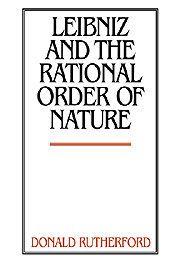5 - The Categories of Thought and Being
Published online by Cambridge University Press: 05 June 2012
Summary
In a series of writings from the late 1670s and the 1680s, we encounter a neglected aspect of Leibniz's views concerning ontology and method. The principal theme of these works is the definition and classification of the fundamental categories of thought and being. In both form and content, these writings suggest a throwback to an earlier philosophical generation. In them Leibniz's model is less the empirically and mathematically inspired method of Descartes, Hobbes, or Spinoza than the “tables of division” and classificatory “systems” of a group of almost forgotten late-sixteenth- and early-seventeenthcentury German thinkers, whose outlook is characterized by an eclectic blend of Aristotelian, Ramist, and Semi-Ramist thinking. The history of this movement and its influence on Leibniz lies outside the scope of the present study. My concern in what follows will be solely with articulating what may be interpreted as its residue in a specific collection of Leibnizian texts. Using this approach, I hope to give further content to the conception of metaphysics outlined in Chapter 4, and at the same time to illuminate several of Leibniz's most distinctive ontological commitments: his much discussed nominalism, his distinction between substantial and nonsubstantial being, and his complete concept theory of substance.
The Encyclopedia and the General Science
Leibniz's arrival in Hanover in December 1676 signaled a crucial turning point in his career. On the one hand, it marked the beginning of his long employment with the House of Brunswick-Lüneberg, an association that would last until his death forty years later.
- Type
- Chapter
- Information
- Leibniz and the Rational Order of Nature , pp. 99 - 132Publisher: Cambridge University PressPrint publication year: 1995



